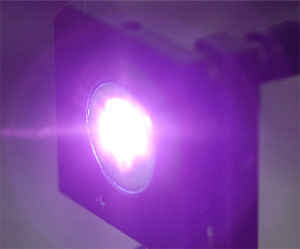LIVERMORE, Calif., March 18, 2009 – High-frequency sounds have been converted into light for the first time, according to scientists at Lawrence Livermore National Laboratory.
By reversing a process that converts electrical signals into sounds, the researchers believe that they have discovered a new tool to enhance the way computer chips, LEDs and transistors are built.
They used piezoelectric speakers, which are commonly found in cell phones, because they operate at a low enough frequency for humans to hear.
A plasma is generated by a laser pulse similar to how sound is converted to light. (Image: Lawrence Livermore National Laboratory)
But by reversing that process, lead researchers Michael Armstrong, Evan Reed and Mike Howard, Lawrence Livermore colleagues, and collaborators from Los Alamos National Laboratory and Nitronex Corp., used a very high frequency sound wave – about 100 million times higher than what humans can hear – to generate light.
“This process allows us to very accurately ‘see’ the highest frequency sound waves by translating them into light,” Armstrong said.
During the past decade, pioneering experiments using subpicosecond lasers demonstrated the generation and detection of acoustic and shock waves in materials with terahertz frequencies. These very same experiments led to a new technique for probing the structure of semiconductor devices.
However, the recent research takes those initial experiments a step further by reversing the process, converting high-frequency sound waves into electricity. The researchers predict that high-frequency acoustic waves can be detected by seeing radiation emitted when the acoustic wave passes an interface between piezoelectric materials.
“This is a fundamentally new phenomenon, and it can be used to probe structural properties of nanoscopic materials,” Armstrong said. “This method has the potential to characterize semiconductor devices more accurately than other nondestructive methods.”
Very high frequency sound waves have wavelengths approaching the atomic-length scale. Detection of these waves is challenging, but they are useful for probing materials on very small length scales.
But that’s not the only application, Reed said.
“This technique provides a new pathway to generation of terahertz radiation for security, medical and other purposes,” he explained. “In this application, we would utilize acoustic-based technologies to generate terahertz.” Security applications include explosives detection, and medical use may include detection of skin cancer.
And the Livermore Laboratory method does not require any external source to detect the acoustic waves.
“Usually, scientists use an external laser beam that bounces off the acoustic wave – much like radar speed detectors – to observe high-frequency sound. An advantage of our technique is that it doesn’t require an external laser beam – the acoustic wave itself emits light that we detect,” Armstrong said.
The research appears in the March 15 edition of the journal Nature Physics.
For more information, visit: www.llnl.gov